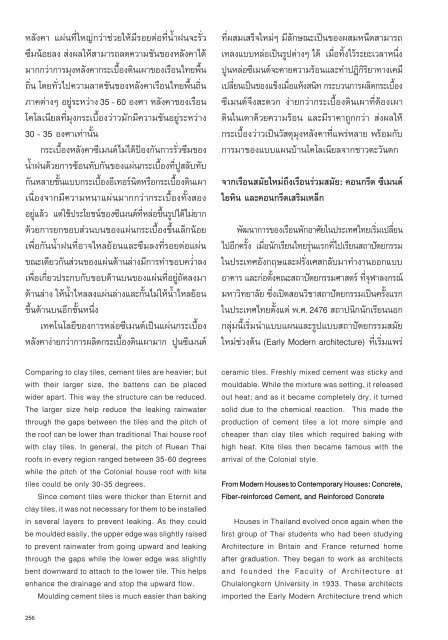บ้านเรือนถิ่นไทยในช่วงเจ็ดทศวรรษ 2489-2559
Create successful ePaper yourself
Turn your PDF publications into a flip-book with our unique Google optimized e-Paper software.
หลังคา แผ่นที่ใหญ่กว่าช่วยให้มีรอยต่อที่น ้ำฝนจะรั่ว<br />
ซึมน้อยลง ส่งผลให้สามารถลดความชันของหลังคาได้<br />
มากกว่าการมุงหลังคากระเบื้องดินเผาของเรือนไทยพื้น<br />
ถิ่น โดยทั่วไปความลาดชันของหลังคาเรือนไทยพื้นถิ่น<br />
ภาคต่างๆ อยู่ระหว่าง 35 - 60 องศา หลังคาของเรือน<br />
โคโลเนียลที่มุงกระเบื้องว่าวมักมีความชันอยู่ระหว่าง<br />
30 - 35 องศาเท่านั้น<br />
กระเบื้องหลังคาซีเมนต์ไม่ได้ป้องกันการรั่วซึมของ<br />
น้ำฝนด้วยการซ้อนทับกันของแผ่นกระเบื้องที่ปูสลับทับ<br />
กันหลายชั้นแบบกระเบื้องอีเทอร์นิตหรือกระเบื้องดินเผา<br />
เนื่องจากมีความหนาแผ่นมากกว่ากระเบื้องทั้งสอง<br />
อยู่แล้ว แต่ใช้ประโยชน์ของซีเมนต์ที่หล่อขึ้นรูปได้ไม่ยาก<br />
ด้วยการยกขอบส่วนบนของแผ่นกระเบื้องขึ้นเล็กน้อย<br />
เพื่อกันน้ำฝนที่อาจไหลย้อนและซึมลงที่รอยต่อแผ่น<br />
ขณะเดียวกันส่วนของแผ่นด้านล่างมีการทำขอบคว่ำลง<br />
เพื่อเกี่ยวประกบกับขอบด้านบนของแผ่นที่อยู่ถัดลงมา<br />
ด้านล่าง ให้น้ำไหลลงแผ่นล่างและกั้นไม่ให้น้ำไหลย้อน<br />
ขึ้นด้านบนอีกชั้นหนึ่ง<br />
เทคโนโลยีของการหล่อซีเมนต์เป็นแผ่นกระเบื้อง<br />
หลังคาง่ายกว่าการผลิตกระเบื้องดินเผามาก ปูนซีเมนต์<br />
Comparing to clay tiles, cement tiles are heavier; but<br />
with their larger size, the battens can be placed<br />
wider apart. This way the structure can be reduced.<br />
The larger size help reduce the leaking rainwater<br />
through the gaps between the tiles and the pitch of<br />
the roof can be lower than traditional Thai house roof<br />
with clay tiles. In general, the pitch of Ruean Thai<br />
roofs in every region ranged between 35-60 degrees<br />
while the pitch of the Colonial house roof with kite<br />
tiles could be only 30-35 degrees.<br />
Since cement tiles were thicker than Eternit and<br />
clay tiles, it was not necessary for them to be installed<br />
in several layers to prevent leaking. As they could<br />
be moulded easily, the upper edge was slightly raised<br />
to prevent rainwater from going upward and leaking<br />
through the gaps while the lower edge was slightly<br />
bent downward to attach to the lower tile. This helps<br />
enhance the drainage and stop the upward flow.<br />
Moulding cement tiles is much easier than baking<br />
ที่ผสมเสร็จใหม่ๆ มีลักษณะเป็นของผสมหนืดสามารถ<br />
เทลงแบบหล่อเป็นรูปต่างๆ ได้ เมื่อทิ้งไว้ระยะเวลาหนึ่ง<br />
ปูนหล่อซีเมนต์จะคายความร้อนและทำปฏิกิริยาทางเคมี<br />
เปลี่ยนเป็นของแข็งเมื่อแห้งสนิท กระบวนการผลิตกระเบื้อง<br />
ซีเมนต์จึงสะดวก ง่ายกว่ากระเบื้องดินเผาที่ต้องเผา<br />
ดินในเตาด้วยความร้อน และมีราคาถูกกว่า ส่งผลให้<br />
กระเบื้องว่าวเป็นวัสดุมุงหลังคาที่แพร่หลาย พร้อมกับ<br />
การมาของแบบแผนบ้านโคโลเนียลจากชาวตะวันตก<br />
จากเรือนสมัยใหม่ถึงเรือนร่วมสมัย: คอนกรีต ซีเมนต์<br />
ใยหิน และคอนกรีตเสริมเหล็ก<br />
พัฒนาการของเรือนพักอาศัยในประเทศไทยเริ่มเปลี่ยน<br />
ไปอีกครั้ง เมื่อนักเรียนไทยรุ่นแรกที่ไปเรียนสถาปัตยกรรม<br />
ในประเทศอังกฤษและฝรั่งเศสกลับมาทำงานออกแบบ<br />
อาคาร และก่อตั้งคณะสถาปัตยกรรมศาสตร์ ที่จุฬาลงกรณ์<br />
มหาวิทยาลัย ซึ่งเปิดสอนวิชาสถาปัตยกรรมเป็นครั้งแรก<br />
ในประเทศไทยตั้งแต่ พ.ศ. 2476 สถาปนิกนักเรียนนอก<br />
กลุ่มนี้เริ่มนำแบบแผนและรูปแบบสถาปัตยกรรมสมัย<br />
ใหม่ช่วงต้น (Early Modern architecture) ที่เริ่มแพร่<br />
ceramic tiles. Freshly mixed cement was sticky and<br />
mouldable. While the mixture was setting, it released<br />
out heat; and as it became completely dry, it turned<br />
solid due to the chemical reaction. This made the<br />
production of cement tiles a lot more simple and<br />
cheaper than clay tiles which required baking with<br />
high heat. Kite tiles then became famous with the<br />
arrival of the Colonial style.<br />
From Modern Houses to Contemporary Houses: Concrete,<br />
Fiber-reinforced Cement, and Reinforced Concrete<br />
Houses in Thailand evolved once again when the<br />
first group of Thai students who had been studying<br />
Architecture in Britain and France returned home<br />
after graduation. They began to work as architects<br />
and founded the Faculty of Architecture at<br />
Chulalongkorn University in 1933. These architects<br />
imported the Early Modern Architecture trend which<br />
256


















